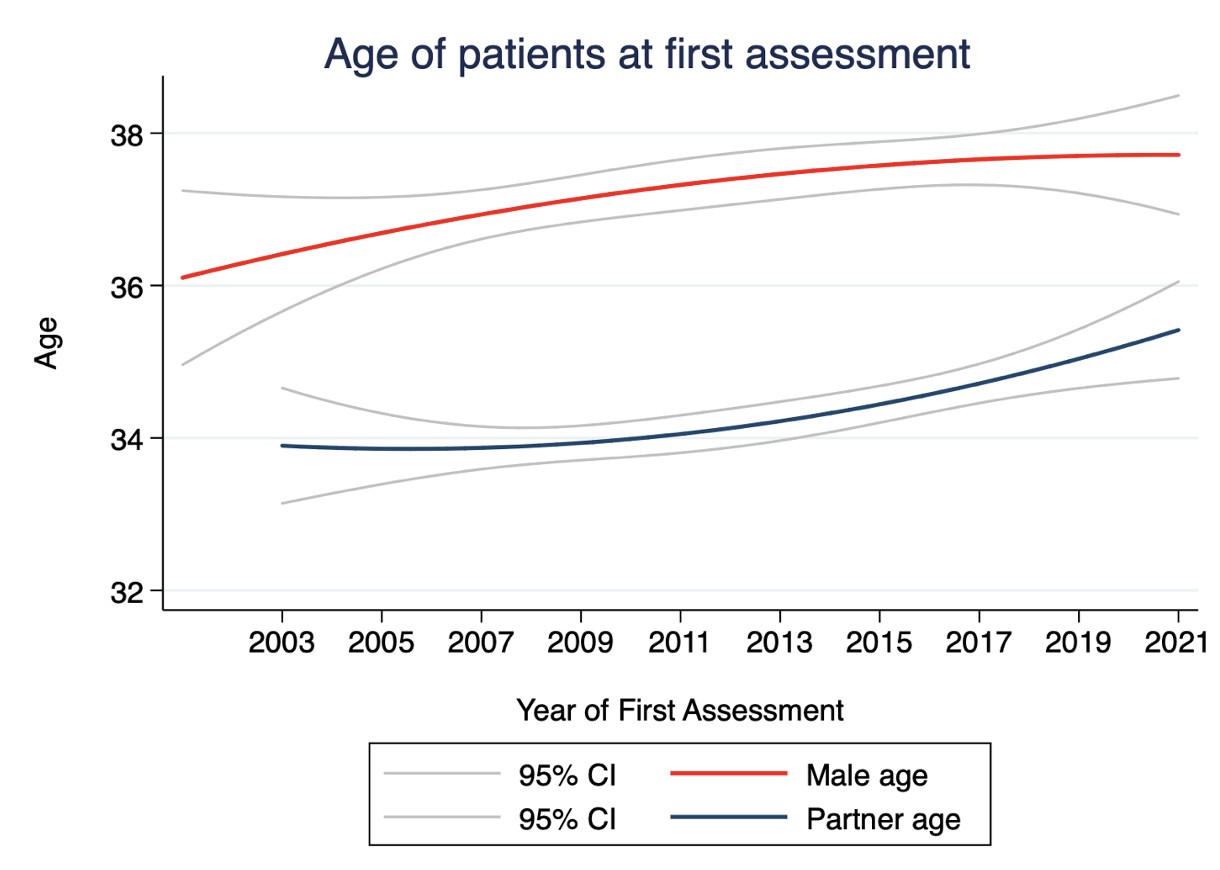Back
Poster, Podium & Video Sessions
Podium
PD20: Infertility: Epidemiology & Evaluation II
PD20-01: Age at presentation of infertile men has stably increased over the last two decades: analysis from a longitudinal study
Saturday, May 14, 2022
7:00 AM – 7:10 AM
Location: Room 244
Luca Boeri*, Milan, Italy, Paolo Capogrosso, Varese, Italy, Giuseppe Fallara, Federico Belladelli, Edoardo Pozzi, Massimiliano Raffo, Christian Corsini, Luigi Candela, Antonio Costa, Daniele Cignoli, Nicolò Schifano, Alessia d'Arma, Eugenio Ventimiglia, Luca Pagliardini, Enrico Papaleo, Milan, Italy, Vincenzo Mirone, Naples, Italy, Francesco Montorsi, Andrea Salonia, Milan, Italy

Luca Boeri
IRCCS Fondazione Ca' Granda - Maggiore Policlinico Hospital
Podium Presenter(s)
Introduction: Population based studies have shown a significant drift towards advanced paternal age at first presentation. Similarly, length of infertility (LOI) has progressively increased over the last decade with negative impact on men’s reproductive potential. We aimed to assess trends of age at presentation over a 20-year time frame in a cohort of non-Finnish white-European men presenting for primary couple’s infertility.
Methods: Data from 3369 men who consecutively presented for primary couple’s infertility at a single academic centre between May 2003 and August 2021 were analyzed. Comorbidities were scored with the Charlson Comorbidity Index. Patients were stratified according to their educational status into a low-level (LL) (elementary or secondary school) and a high-level (HL) (high school or university). Data about the age of patients’ partners and LOI were also collected. Descriptive statistics and linear regression analyses detailed the association between demographic, clinical predictors and patient’s age at presentation.
Results: Throughout a 18-year time frame, median (IQR) patient’s, partner’s age and LOI were 37 (33-41) yrs, 34 (31-37) yrs and 20 (12-36) months, respectively. Patient’s (beta 0.07, p=0.03) and partner’s age at presentation (beta 0.09, p<0.001) increased over time (figure). Conversely, LOI decreased across the same time frame (beta -0.5, p<0.001). Age at presentation increased from 2003-07 to 2008-12 (p=0.02) but remained stable thereafter. On the contrary LOI significantly decreased from 2003-07 to 2008-12 (p < 0.001), being stable afterwards. Partner’s age increased from 2008-2012 to 2017-2021 (all p<0.01). HL educational status was more frequently found in men presenting between 2018-21 compared to 2003-07 (50.6% vs. 31.4%; p<0.001). Multivariable linear regression analysis revealed that year of presentation (beta 0.12, p<0.001), partner’s age (beta 0.6, p<0.001), LL of education (beta -0.9, p<0.001) and LOI (beta 0.02, p<0.001) were all associated with older age at presentation.
Conclusions: Both patients and partners’ age has increased over the last 18 years in primary infertile couple at first presentation. Of note, male age was almost stably high over the last 10 years while partners’ age still increased. LOI has decreased over time
Source of Funding: None

Methods: Data from 3369 men who consecutively presented for primary couple’s infertility at a single academic centre between May 2003 and August 2021 were analyzed. Comorbidities were scored with the Charlson Comorbidity Index. Patients were stratified according to their educational status into a low-level (LL) (elementary or secondary school) and a high-level (HL) (high school or university). Data about the age of patients’ partners and LOI were also collected. Descriptive statistics and linear regression analyses detailed the association between demographic, clinical predictors and patient’s age at presentation.
Results: Throughout a 18-year time frame, median (IQR) patient’s, partner’s age and LOI were 37 (33-41) yrs, 34 (31-37) yrs and 20 (12-36) months, respectively. Patient’s (beta 0.07, p=0.03) and partner’s age at presentation (beta 0.09, p<0.001) increased over time (figure). Conversely, LOI decreased across the same time frame (beta -0.5, p<0.001). Age at presentation increased from 2003-07 to 2008-12 (p=0.02) but remained stable thereafter. On the contrary LOI significantly decreased from 2003-07 to 2008-12 (p < 0.001), being stable afterwards. Partner’s age increased from 2008-2012 to 2017-2021 (all p<0.01). HL educational status was more frequently found in men presenting between 2018-21 compared to 2003-07 (50.6% vs. 31.4%; p<0.001). Multivariable linear regression analysis revealed that year of presentation (beta 0.12, p<0.001), partner’s age (beta 0.6, p<0.001), LL of education (beta -0.9, p<0.001) and LOI (beta 0.02, p<0.001) were all associated with older age at presentation.
Conclusions: Both patients and partners’ age has increased over the last 18 years in primary infertile couple at first presentation. Of note, male age was almost stably high over the last 10 years while partners’ age still increased. LOI has decreased over time
Source of Funding: None


.jpg)
.jpg)